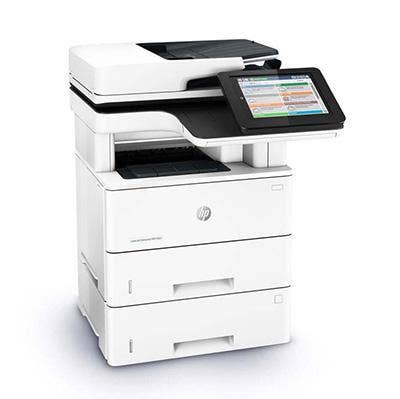CRN Exclusive: HP Imaging President Enrique Lores On The A3 Sales Charge, The 'Huge' Smart Delivery Services Breakthrough, And Future Sensor-Software IoT Innovation

Leading The A3 Sales Charge
HP Imaging and Printing President Enrique Lores says the printer market leader's new A3 copier replacement product portfolio, which began shipping last week and is being carried by 500 partners, already has a solid sales pipeline.
"Our focus now is making sure that the customers and partners when they get these products for the first time are really delighted," said Lores in an interview with CRN. "All the plans are in place. Now it is time to make sure that everything works and those first engagements exceed expectations."
Partners say Lores' leadership has set the stage for them to take a big bite out of what amounts to a new $54 billion market opportunity. They say the A3's 20 percent to 30 percent lower cost of services model powered by the A3's Smart Delivery Services (SDS) Internet of Things sensor/software innovation is a channel game-changer.
"It is a huge breakthrough because we are bringing the intelligence of IT to the copier world," said Lores of the SDS model. "What we have done is bring some of the capabilities that you have today to manage servers, networks and PCs to copiers. So the printers will be telling us what is about to break, what parts are wearing out."
Lores spoke with CRN about the A3 sales offensive, the breakthrough smart services delivery model, and future sensor/software-based Internet of Things innovation.

How does it feel to finally ship A3?
We are really excited that we have met our commitments in delivering our printers. We are very excited about the funnel of opportunites that we see. We have been engaging with partners all over the world to make sure they engage with us to ensure they have the right level of training to sell and support the printers. We are ready.
What types of partners are selling the new A3 lineup?
There are 500 partners worldwide. It is both copier partners and IT guys that were ready and willing to make the investment to go into this business. It is a new business for them. It is mostly the IT guys who are already doing managed print services.
Overall, we have the number of partners we wanted. We defined how many we needed to achieve the volumes and share that we have as a goal. The product is ready, the channel is ready and now we have to start selling and delighting customers.

How natural a play is the A3 for partners already doing managed print services?
It is more than a natural extension. They have already been managing the printer fleets for their customers. This gives them another option to redesign the fleet and make it more efficient, to change the balance of the centralized equipment that they have. This enables them to reduce cost per copy as they replace some of the copiers with lower-cost A3 printers. With PageWide they can reduce the price per color so they can make color more progressive. But it is a very natural change for them. It is a very logical next step to add A3 with the A4 MPS contracts they already have.
Talk about the 20 percent to 30 percent savings in services costs for customers deploying A3s.
The 20 percent savings is with the laser printers, 30 percent is in the case of PageWide. Our plan is to continue reducing that with something we call SDS, Smart Delivery Services. What we are providing with SDS is the ability to manage the printers remotely and facilitating remote management and preventive maintenance.

How big of a breakthrough is SDS is for customers?
It is a huge breakthrough because we are bringing the intelligence of IT to the copier world. What we have done is bring some of the capabilities that you have today to manage servers, networks and PCs to copiers. So the printers will be telling us what is about to break, what parts are wearing out. We are building a lot of technologies and integrating a lot of sensors into the printers to really make this very efficient. Next time we talk there will be more innovation coming in this space. We see this as an opportunity for continuous improvement over many years.
What type of investment is HP making with SDS?
It is all about sensors and software. It is all about integrating sensors in the printers from temperature sensors to even noise sensors, sending the information back and through big data analyzing that and getting insights from our big installed base of printers.
Once you start capturing the data and you manage it with all the tools that we have today with big data, you can really have and create a lot of intelligence.
We have talked about the Internet of Things. We really think our printers are Internet of Things devices. They bring all this data back to the cloud. We can process that and use it to continue to reduce costs.

Is the A3 the first IoT-based printer for HP?
At a professional level, definitely yes. It is sensors, software, big data, the cloud. It is building the capability to capture the data, sending it back. Analyzing it and remotely managing the printer.
How does the partner play in the new IoT A3 printer world?
The partner get access to all the information and starts seeing the signals and the reports that the big data will provide. And through the same tools that we are using now they can control the printers. They can do a reboot remotely. If the printers need to be rebooted, they can do that. If they need to download new firmware, they can do that remotely. We are simplifying the whole process, but the partner is in charge.
The printer sends information, which is sent to the partner and the service group for the partner to decide how to handle each case. Our model is partner-centric. All the tools and systems and new capabilities we are building were designed to make partners more efficient. That is our value proposition: a more efficient system for partners so they can either be more aggressive with their [price] quotes or make more money.

How important is it that partners are services-oriented in this A3 market?
It is a services-led model. This has been one of the areas where we have made more investments – making sure that our processes to manage services are ready, making sure that partners have access to spare parts when they need them, making sure that all our partners have been trained already so they can support the printers -- both PageWide and laser.
We have made sure partners have access to and understand the tools to remotely configure and manage the printers. Building the training and infrastructure – making sure all the processes are there to support them -- has been one of the key areas of focus as part of the launch of the printers.

What is the new sales model for the A3 printers and how it is different than the traditional managed print services model?
This is a different model from the one we are used to. I think the A3 model is an extension of the managed print services model. For years we did not [have] an A3 in the portfolio and this was limiting our ability to win certain print management services deals. Now that limitation is gone. We were already the fastest-growing managed print services business in the world. With the addition of A3, we will continue to accelerate that growth. It is completely synergistic.

How big an impact could this have on partners’ managed print services growth?
This is going to more than double the opportunity for partners that were doing managed print services. They were previously only able to play in the A4 market. Now they can also add A3 to their portfolio and grow their MPS engagement with customers. So it is a significant opportunity for partners to grow while at the same time they can use a consistent set of tools, capabilities and knowledge that they built for A4. It is very important for them.
For partners that were considering building a managed print services practice, this is the right time to get into it. This business is only going to accelerate as a consequence of the launch of A3.

What is the partner interest in A3?
We have seen very strong interest across the board for HP to enter into this market. That has been a confirmation that this is a great opportunity for HP and also for our partners.
What are the sales goals for the A3 line?
Without mentioning a specific number, our goal is to become a relevant player in the A3 industry. We are not relevant today. It is an adjacent market to where we have been playing for many years. It is an adjacent market to segments where we are the leaders. Our goal is to be as fast as possible to be relevant. And to be relevant you need to be in the 10 percent [share] range.

What is the sales pipeline like for A3?
The pipeline looks very solid. I have very strong confidence in the plans that we have. Our focus now is making sure that the customers and partners when they get these products for the first time are really delighted. They are delighted with the units because of the quality of the units. They are delighted because we have met all of our time commitments, because printers arrive on time, accessories arrive on time, spare parts are ready. All the plans are in place. Now it is time to make sure that everything works and those first engagements exceed expectations. This is where our entire organization is focused right now.
What is your call to action for partners doing those first A3 engagements?
The call to action is really to go out and sell aggressively our value proposition. We think we have a winning portfolio and a winning set of services that will enable partners to delight customers, and help them win more and be more profitable. We want to make sure partners are very close to us. We know that we still have many things to learn. We are humble. This is a big opportunity. We are in it for the long term. We are looking forward to learning from them, learning with them and working with them very closely in the first months of the launch is going to be very, very important.

How important is listening as you launch the A3 product into the market?
We need to listen. And I have big ears so I have an advantage. We are taking a very humble position. We know that there are many things we need to learn about. This is a relatively new market for us. We think we have a lot of great assets, but we know there are things that we will be learning and changing. We are here for the long term. We want to learn and work with our partners to succeed together.

Talk about the A3 product journey from announcement now to delivery.
We announced A3 in October and it is finally here. We have 16 new A3 products.
We are delivering on the A3 value proposition -- 20 [percent] to 30 percent lower service cost than any other copier in the industry today. Our goal is to disrupt the copier industry. We are not introducing traditional copiers – we are introducing printers with the performance and cost per copy that only copiers have had so far.
We have a road map to maintain our advantage in service cost by making the printers more reliable but especially by improving the connection between the printers and the system engineers. The printers proactively will tell what is not working or wearing out so we can facilitate and enable preventive maintenance and make sure the printers can be managed and can be supported remotely.
We have changed our approach to tools and, rather than using our own tools, we have made a big effort to support industry-standard tools. The same tools that customers have been using now they will be able to use to support HP printers. So their transition from their current models to our models will be much easier. We think this is going to be a key enabler of our progress.

How big a difference is the ability to support third-party tools?
We had our own tools integrated in Jetadmin and Web Jetadmin. What we have done now is, country by country, region by region, identify what are the tools that customers are using to manage their [A3] copier fleets and leveraging then.

How big a change is it for HP to leverage those third-party tools?
It's a big thing. We think customers prefer not to change the tools they are using. In many cases, they have some of our printers and competitors' printers. We want to make the change to [our A3] as smooth as possible.
We made that decision a year and a half ago. We decided to make it a big advantage and partner with the key vendors in the industry to make sure they are supporting our A3s.

What has been the reaction from the copier partners you have recruited to sell the HP A3 line?
They love the approach. In a different model, they would have had to learn a new tool. Now they can continue using what they have been using for years. We have had an extremely positive reaction from partners and end users.